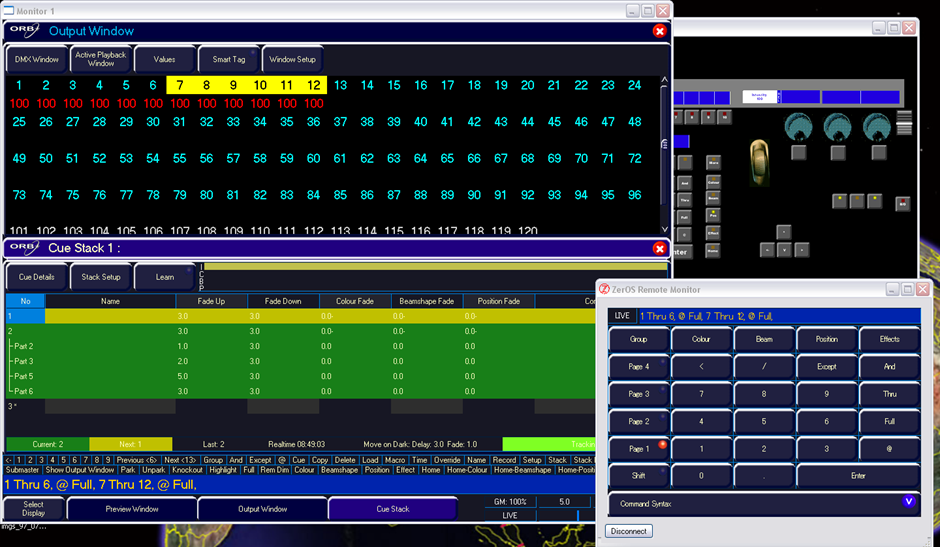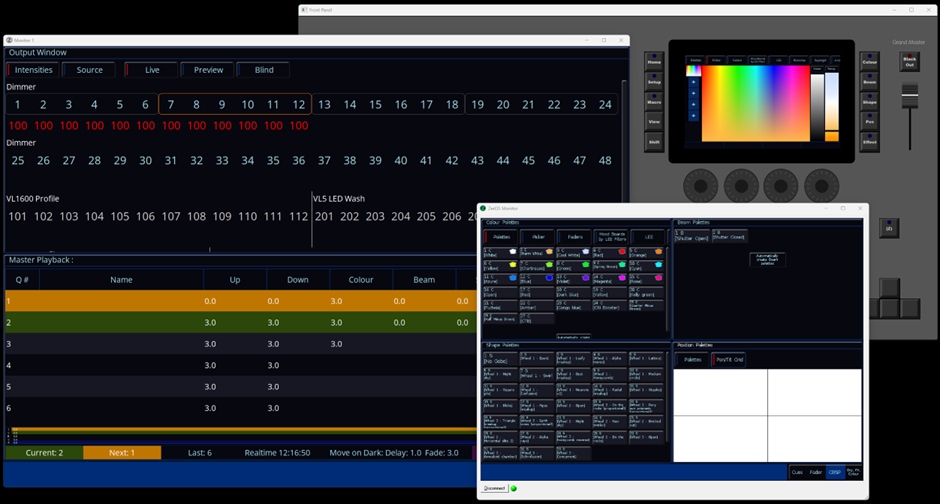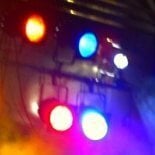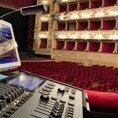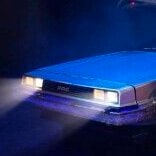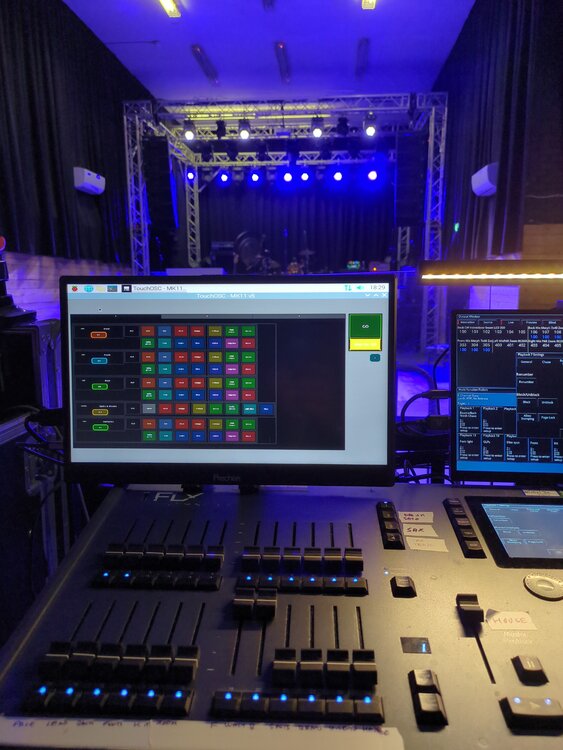Leaderboard
Popular Content
Showing content with the highest reputation since 12/14/2024 in all areas
-
I expect I am one of the older (age) members of the Forum doing my first stage lighting in January 1975 when I was 19. In the 50 years since I have hired and owned many types of lighting desks including those from Zero 88. For 12 years I was using an American computer based desk which was fine untill the company was taken over and things started to change. Support staff left and software development slowed to a crawl. At this time I knew I had to change and along came the FLX S48 which a school I was working in had just bought. Afterwards I went to one of the Zero 88 roadshows at Exeter University and shortly afterwards bought my own because I liked it so much. Fast forward 6 years and I am sorry to see the main support team change so much. I wish everyone well in their new ventures. I hope this is not the thin edge of the wedge. Best wishes to everyone for their productions for 2025. I hope you all enjoy things as much as I do for many years to come. With kind regards Trevor Steer7 points
-
Hi all, To ensure Vari-Lite can provide the best possible support, I’d like to quickly remind everyone of the three active support routes: Emailing entertainment.service@signify.com or calling +1 214 647 7880 (While the legacy Zero 88 contact methods are still monitored by the UK-based support team, the above contact details are the “official” routes which are monitored by the global support team). This “Vari-Lite Controls Support Forum” (Over the years this has become a fantastic resource of data and is home to some very knowledgeable users. The Vari-Lite team regularly monitor the forum (your forum admins are Darren - @DMH and Ryan - @RJP from the UK-based support team). However, if you require immediate direct support from Vari-Lite, the contact details above are the correct method). “Vari-Lite Console Programmers” Facebook Group Lastly, I’d like to take a moment to say farewell, as I’m stepping down from the team. I’m so proud of the products we’ve launched over my time - FLX, ZerOS Wing, FLX S24 & S48, ZerOS Server, RigSwitch, AlphaPack 3, BetaPack 4, Splitter 8, Gateway 4, Gateway 8, Neo X15, Neo X5, Neo X Server and RigSwitch+. And I’m delighted to have finally released ZerOS 8! Here’s a couple of ZerOS screenshots comparing when I started (ZerOS 5.4), to now (ZerOS 8): But it’s not all about the products - there’s been so much more too. Three (1, 2, 3) PLASA Awards for Innovation, several patents, our industry’s best RDM implementation with RigSync, the first console to implement Art-Net 4, Zero 88’s 40th Anniversary and the “Me and My Zero 88” competition, being ahead of the curve on natively supporting GDTF, the Simplifying Jargon videos, “Live at the Congress” Events and #WeMakeEvents campaigns over COVID, updating the Zero 88 website, our yearly Advent Calendars, our April Fools Day posts (anyone remember FLX switching to Roman Numerals or the new ZerOS Wing SD?) and the High Altitude Balloon into near space competition. So many great memories, fun, experience, knowledge and friendships have been made during this time which are, and will continue to be, very, very special to me. The Vari-Lite team are committed to continuing this good work – with plans to develop and support both ZerOS & FLX S, along with RigSwitch+, Neo X and VisionNet. I wish them all continued success with those projects. So, from me, it’s Time to Say Goodbye. And thank you.6 points
-
Vari-Lite has announced the ZerOS 8 software update for FLX, FLX S and ZerOS Server. The update doubles the capacity of Vari-Lite’s FLX S Series consoles, removing the need for paid universe upgrades, and further increases the integration between Vari-Lite’s FLX S consoles and new RigSwitch+ power platform. With ZerOS 8, FLX S24 & FLX S48 now support 96 & 192 fixtures respectively, both now across 2,048 DMX channels (equivalent to 4 full DMX universes). Not content with doubling the fixture count and channel license, ZerOS 8 also doubles the number of playbacks, groups and palettes available on all FLX S consoles. The full size FLX and ZerOS Server also receives an upgrade to 4,096 channels (equivalent to 8 full DMX universes). With ZerOS 8, users can add relay circuits to every fixture on their console without further eating into their fixture count. These relays can be manually controlled or users can allow ZerOS to automatically control the relays - switching each individual circuit on when the fixture plugged into it is needed, and switching it off when they’re not. Vari-Lite has also simultaneously released ZerOS 7.14.4 specifically for legacy ZerOS consoles, improving both performance and stability to these consoles. Download the latest version of ZerOS free of charge from the Vari-Lite website: https://www.vari-lite.com/global/products/zeros-software6 points
-
Hi all, I've been reading your replies and they've really meant a lot to me, thank you. I've deliberately waited a few weeks before replying. All the very best for the future and, if you're at a trade show in the future, please come and say hello - this LinkedIn post shows where I've headed to, if you're interested! Jon5 points
-
Good luck Jon but I'm not surprised. TBH since the Varilight take over it's felt like the beginning of the end. The issue of the latest software will probably be the last so I hope we all got our wish list items sorted.5 points
-
My sentiments exactly. Keith, Edward and now you. My disappointment knows no bounds.5 points
-
I notice the two support personnel Jon quotes above have a combined contribution of posts on this forum of exactly zero (since Sept/Nov 2024 when they joined). Looks like we're on our own folks, or they've got some work to do to establish their credibility and start making an active contribution - which I guess is part of what they are paid to do (unlike us). A 'hello' and a short resume would be a start…4 points
-
My post on the topic of OSC use with the Zero88 FLX S24 may be of interest. All free software and might give you a start in understanding the process.3 points
-
Hi @SoleJan Blue UP to the sky, green DOWN to the grass. (Blue means that channel intensity went up, green it went down.) White, it's a blocking value, purple it's tracked. Red from the programmer (highest priority), yellow for some other controller. Red background is Parked. Grey background (for a short time) is moving on dark. They're all here: https://www.zero88.com/manuals/zeros/desktops-windows/output-window#colours3 points
-
@DMH @RJP To be fair, some good answers there and, if delivered, could help the situation but... How it looks is important. In the absence of a published plan and feedback on progress, its all we have. We used to have trust but that has to be earned so, come on Vari-lite, start looking better. You've bought the rights to good hardware and software with an established customer base - many of whom have been using Z88 products for years, decades even @pcollins666. An unpaid sales force that was more than happy to sing the praises of a company that looked after them, had a solid track record of supporting them and of steady innovation. What do you think those established customers are saying to your potential customers now? It's clear the full FLX had to be discontinued but there's no talk of a replacement. The in-person training has stopped. Cwmbran is no longer a service centre and there are none listed on the Vari-Lite Web site in the UK (the two "dealers" listed are a 2nd hand equipment seller and a hire company). Plus, to return to the origin of this thread, there is now a charge for fixing the (inevitable) gaps in the fixture library. These things are probably not Vari-Lite's fault but what is being done to address them? How could I, in all conscience, reccomend a Z88 product today?3 points
-
As a Zero88 stalwart user and supporter for more than 30 years, I asked a few questions just about what we might expect in the way of support following Edward & Jon’s departures. I did receive a prompt reply in red below. It at least gives their intent and maybe a base for us to push from…. With my two good friends, Jon Hole & Edward Smith departing in quick succession, can you describe the changes to the support services that we are likely to see going forward. I understand how this must look but I would like to reassure you the software development team that are in the background are still very much here and as will has a dedicated support department. The support department is manned in the UK and US so we can offer better global coverage. Up to this point I’ve had personal FLX Support response to emails usually within one working day. We do still try to respond withing 24/48 hours to direct emails, however this will also depend on workload as we also cover on site visits. Instant phone call response for show critical issues. Are there still FLX console experts available to take technical enquiries? We have and have always had an out of hours emergency response number, this is available from the Vari-lite website. Please find below the link. https://www.vari-lite.com/global/support/technical-support Daily monitoring and responding to forum posts, usually within one working day. No spam posts. The forum appears already to be out of control. The forum has slipped behind as we have been dealing with direct customer support, we are currently working on a solution to this. Fixture Library addition requests created and emailed back usually within one working day. We are creating fixture files for customers but as the workload has increased we have had to increase the estimated turn around time to up to a possible 21 days. We understand this is a big difference and we do endeavour to do them ASAP which is usually between 1 and 3 days. If the file is urgent, we recommend the customer creates the file themselves as this is a very easy process within the ZerOS Software, please see the link below. https://www.zero88.com/manuals/zeros/patching/add-fixtures/fixture-creator Ongoing ZerOS development with bug fixes and new features. Are there still dedicated ZerOS software developers actively in post? As I mention above, the software develop team has not changed this has in fact increased with developers in the UK, US and New Zealand. A roadmap for ZerOS progression, shared with users. A monitored ‘What would you like to see in ZerOS’ poll. Regular beta testing releases with feedback being acknowledged and logged. Updates and improvements to training manuals and YouTube content following ZerOS releases. Thank you for your suggestions, I will forward them to the product management team. As you can see from the above, Zero88 provided a truly comprehensive service to its users, at no extra cost. I would like to hope that a similar service will continue to be provided from the company that has the iconic and industry respected name of Vari-Lite. Thank you for your questions and I hope you find our response reassuring. We are constantly looking at our processes and internal procedures to improve the customer experience.3 points
-
The answer to that lies in this forum over the last few months. As a 30 year user/buyer myself, it’s spelled out in big fat letters. It’s the end of the line folks I’m afraid, they’re not interested. Jon managed to get in a last gasp with ZerOS 8 before he left. That will be the last, I’m sure of it. Zero88 and its beloved products and employees are no more.3 points
-
@Jon Hole I wish you future success in your forthcoming move. I think Zero88 now have their work cut out to maintain the support levels we have enjoyed in recent times.3 points
-
I'm my red mist I've so far failed to acknowledge @Jon Hole. My apologies. Thanks for so much Jon over the years - great products, accurate and timely support, recruiting some other great team members, and putting up with some quite strong feedback and comments from us on here. You will be missed as will all of the legacy Z88 team. Good Luck!3 points
-
I took "forum admins" to mean they sort out the forum when it dies and deal with inappropriate posts. So, yes, my assumption has been that the prompt and helpful days of Edward and Jon are over and we are, as you say, "on our own". I, for one, would be delighted to have this cynical and depressing assumption proved wrong. The newish thread - 16 bit intensity really 8 bit - is one that seems to require their attention (even though you have tried to help).3 points
-
Que dire de plus, sinon la même chose qu'à Edward : Merci Jon pour ta pédagogie, ta patience, la pertinence de tes réponses, cela a toujours été un plaisirs d'échanger avec toi, un grand professionnel qui m'a toujours bien aidé ... bonne continuation à toi3 points
-
What? No! I only just discovered Edward had gone. Pantos will never be the same again. Many thanks for your above-and-beyond support for a little minnow. Simon in Wargrave.3 points
-
Wow, is really the end of almost an era and of those I knew in Cymbran. Thank you for all your help and guidance over the years. Will miss catching up with you when I was driving by and also at the trade shows 😢 @Jon Hole all the best for the future3 points
-
Hi Scottydog75, Apologies for the delay in response. The software team are in the process of finishing the next beta build for ZerOS. This should be released for testing on the forum within the next couple of weeks. Kind Regards2 points
-
Hello Oliver_74 You can use the Add as additional address function found in the Edit DMX Address window to pair your five fixtures. When you select the DMX address of the first fixture you want to pair, the curser will flash in the DMX address window which will be blank. Type in the address of the second fixture in the pair, select Add as additional address, then Enter. The Fixture schedule window will show two addresses for the channel fader of the first fixture. I only found this last week when I wanted to pair dimmer channels under one fader.2 points
-
I can confirm that the Flx S48 console worked well using about 2000 channels with 2 Artnet node and 13 used universes2 points
-
Hi all. The iOS apps are now back on the App Store in their original capacity and under the same links they were before. ZerOS Monitor -> https://apps.apple.com/gb/app/zeros-monitor/id1033159176 ZerOS Remote -> https://apps.apple.com/gb/app/zeros-remote/id367342433 (cc: @Charlie Newman @Philh @ATC Tech)2 points
-
Thanks everyone for your help on this, after digging through a good few training webinars on YouTube, I came across the simplest answer - offset, specifically how the offset fans across fixtures. You can change this behaviour by holding setup and tapping effects. I set my shift click to be 'fan first' (Also experimented with the other fan options for different effects) then selected my fixtures, hit chase, held shift and span the encoder wheel to fan the offset of the effect until the chase matched up on all battens. Worked super nicely and certainly opens up some more interesting possibilities for programming Battens Chase LQ.mp42 points
-
A JOS file is likely to be a showfile. A fixture personality file is an IFT file so it may be they way you're trying to load the IFT file? Found this from Ed on another forum... The <Update Library> option in Super User can be used to update the fixture library on the console. If you just wish to load in a fixture file, not a whole library, please see page 49 of the Jester TL manual for information on assigning fixtures… https://www.zero88.com/storage/downloads/5ebda1d3-7348-4727-ae31-fecedf299a46/Jester-TL-and-TLXtra-Manual-3.0.pdf#page=492 points
-
2 points
-
@DMH@RJP The SPAM postings seem to be on the increase with over 40 in last 24 hours plus others highlighted but still on the forum. Please can some trusted forum members be promoted in a way to allow removal of these posts?2 points
-
Smart tag... Great at what it's meant for (recording cues in a stack for playback "on the button") confusing and a nuisance under other circumstances, especially for setting up a desk for busking (IMHO). Tracking similar. Default values, again great at making sure something happens when you raise intensity but default colour of white seems to throw a lot of people. Personally, I set R=G=B=0 as default for all RGB fixtures as a matter of course (and then get confused when I raise intensity and get full on black before remembering that was what I asked for 😁). Whilst having a mini rant... social media may not be the best place to look for help @kgallen and I and a few others watch this forum regularly and there's a lot of expertise here.2 points
-
Hear hear... Where's the downvote button when you need one ⬇️ I wonder how long until the FLX S is canned - I had slight optimism at the ZerOS 8 launch that it sounded like FLX S would be hanging around for a while (https://www.vari-lite.com/global/news/releases/zeros-8-0) - perhaps not much longer with the 'core' Z88 team all gone now. Still wonder if we'll ever hear from our new Vari-Lite admins on this forum? (it's not too late to introduce yourselves, we don't bite! Would be great to get some of your insights on the future of FLX to allay our concerns!) Signed - a loyal Z88 user2 points
-
@Davidmk I suspect you are pretty much bang on with all you say. I don't think Vari-Lite are interested in the console business, or any of Zero88's products. I think Zero88 was just a tiny operation that came along with their bigger purchase of Signify (or whatever transient companies bought the stable that included Zero88 on the way). Zero88's Cwmbran manufacturing operation is (/was, if it still exists) pretty much over to subcontract electronics build. They'll make a few Zero88 product batches as and when demand requires it. I suspect that will dwindle and drop off as demand drops and the lack of successor products means the Zero88 brand disappears. This forum will be funded until someone high up in VL realises they are spending money on it and/or the traffic drops off to a level they think there is no need for it any more. We've probably missed the boat but it would be desirable to get the schematics, Bills-of-Materials and if possible software source code out of the remaining Z88 databases and into the "public" domain before VL type "rm -rf /*" on it all and forget it ever existed. The software source code might be tricky as it might contain sub-licensed IP such that it doesn't have a GPL type license, I don't know, this is not my area. I've not heard anything about any new products with the Z88 brand and there is no evidence to date on the beta forum of ZerOS development work post 8.0 (although JonH did suggest there was an ongoing development plan on his leaving speech). But I don't think there is "anyone" left from Z88 to do this. I think Simon, the key software guy, was probably a sub-contractor [I could be wrong], so will have moved on to other ventures to keep paying his mortgage. If he is about, he's been very quiet and hasn't posted on here at all to say "don't panic guys, we're still here (just)". Time will tell. But I'm not holding my breath.2 points
-
If Vari-lite aren't interested in ZerOS, it would be good if they could put the source code in the public domain so it could be turned onto an open-source project.2 points
-
Spam seems to be getting worse on the daily! Perhaps some sort of user verification is required?2 points
-
Hey, so I tested the show file during the final rehearsals on Friday and on two shows today. They work perfectly. Without you, those fixtures wouldn't have been used in this production. Thank you SOOOOOO much, you're the best! ♥ ♥ ♥ All the best from Leipzig Lena2 points
-
Update as promised: Using the personality in the desk, and when viewing the DMX Output charts under the Z Key, the values corresponding to CMY remained on '0' even after changing colour parameters, or running colour effects etc. Definitely confirmed it was a personality error at this point. So using the inbuilt fixture editor, I took a copy of the existing personality and amended the CMY control channels to be 'Other Colour' control parameters. This worked and enabled the encoders to control the CMY parameters, however colour palettes or picker didn't work as the desk didn't know what colour they actually were. So I then edited the 'copied' personality, changed the 'Other Colour' parameters back to CMY, which then worked as it should have done so in the first place. I now have full control of CMY, using colour palettes or the colour picker! No idea what was going on, but quite the oddity and an annoying time sponge trying to resolve! Either related or unrelated, I also had the desk crash four times throughout plotting, so will forward on the crash reports to the team after the show is done. Thanks again all for suggestions, research, and the created fixture profile @kgallen2 points
-
Hi @Lena Here you go, all three modes (phew!). Everything is in there including all channel "details". You will find lots of channels under Colour and Beam(shape) so you'll have to rotate through the "pages" of them on your S24. However there is a limitation in what I've created. The FLX S24 will support multi-cell fixtures and the TMH-W555 looks like it could benefit with being defined as a multi-cell fixture for the 36 and 48 channel modes. However the Windows Fixture Editor does not support this (as it's a new console feature). You would need to request such an enhanced fixture definition from Vari-lite (or write one using GDTF which I'm not capable of!!!). I'm not sure if the colour palettes will work in the 36 and 48 channel modes as I've not picked any of the RGBW 1/2/3/4/5/6/7 as "primary". But they should work fine in the 24 channel mode. You'll have to see how you go on in 36/48 channel mode and come back to me if it's a little unworkable - I would need you to tell me which segment 1-7 you want to be "primary". Just put this file on a USB stick and use Load on the console. When you patch it, it will show in red text as a "non-library fixture". Enjoy! (ps there is a lot of info I've had to enter so if you see an error or spelling mistake, let me know) eurolite_tmh-w555.ift2 points
-
Raise lower effectively emulates moving the faders, which are limited to 8bit. All other calculations for fades etc, are 16bit. I have raised this as issue ZOS-12581 for future consideration.2 points
-
Thanks guys, saving a group with intensity is a great help. Confirmed it doesn't link the group level into the cue, so unlike a palette, changes to the Group levels don't affect existing cues. I also found the trick to turn off Smart Tag so I can save lights into the Group with zero intensity. Allowed me to clean up existing cues that were a bit randomly balanced so they're all identical. S2 points
-
Wasn't expecting to see this, thank you for all of your support @Jon Hole, hopefully the other support reps will be able to match your knowledge and activity. I wish you all of the best in the future, you'll be sorely missed!2 points
-
It had been set to flash, rather than Go(Fade). I will set back after current show is finished. We have been running the show on one of the sub-masters which works fine. Thanks for the hint.1 point
-
OSC is really useful from my perspective for when you just want to run your show off one main control centre, but not having lights + sound (and possibly projection) all programmed in on a singular machine. If that one machine goes down, you've lost all lights, all sound and all projection. Whereas, if you run lights separately with the computer controlling sound and projection, while a lighting console is controlling LX separately, if the main computer goes down then you still have light on stage and can control that independently. Something like this can be done with OSC via QLab (with Network Messages) however QLab does require a license for this, or using something like Multiplay (another sound + projection cue-based tool) as @Neil Macmillan has used, is another option that is free to use (but still very very good!). So, if you are looking for a cue-based solution and you use a Mac, QLab is probably the best option (you could have a "magic sheet" as @Davidmk has, using Cue Carts within QLab). These "cue carts" can fire Network Messages over OSC to trigger certain cues on the LX console, like a soundboard but for lights. However, if you use Windows, Multiplay is also a good option (not sure about cue carts on it though). If you're on a Mac and instead of using QLab, you want to use Multiplay, you could run it via Wine but this won't run natively on your Mac and I'm not sure if OSC would work with how Wine handles things, but it could be worth a try. Unfortunately QLab on Windows isn't an option as it is developed primarily on the Apple platform, and so relies on Apple infrastructure for features such as AppleScript integration. QLab Network Message Cues - https://qlab.app/docs/v5/networking/network-cues/ QLab Cue Carts - https://qlab.app/docs/v4/general/cue-carts/ If you do use Multiplay, I very much point you to Neil's video! (I used it myself when having a play with OSC over Multiplay to my Phantom ZerOS setup, so thank you very much Neil for making that video). Best of luck with what you want to do with OSC.1 point
-
Good stuff. In my world it's mostly busking so I'm using TouchOSC to give me a "magic sheet" where I can select colours, positions, effects, whatever by touching a button. The buttons fire specific cues in cue stacks. For example, I might have a stack with cues to set colour (and only colour) on some wash lights. Each cue has a 2s fade time. The buttons each trigger one of these cues and, because it is a cue stacks, I get the fade and the old colour gets faded out. I also have a button that releases the stack so, for example, I can release the effects stack when I'm done with it.1 point
-
Hi @Tim Molyneux, the above post should definitely solve your problem (thank you @mikeb) as you are trying to load in a fixture personality file in the way of loading a fixture library file onto the desk. Using 'Assign Fixtures' -> USB as described in the manual above will work. Regarding this, I thought I'd just chip in and mention about file formats for future reference: JOS files are the file format for the Jester operating system when updating the console's OS. JSF files are showfiles for Jesters in the 12/24 and 24/48 range. JML files are showfiles for Jesters in the ML range, TL and TLextra range. I hope this is of use for the future for file format knowledge. Edit: To add, I have attempted to upload the IFT file provided above on my own JesterML console using the method in the manual via 'Assign Fixtures' and it does load in correctly.1 point
-
This is why we’re here! Keep asking/sharing and we’ll do our best. If you can help out another user - either directly by asking a question of your own which is answered, or more directly, then even better. That’s how this forum works, especially now the Vari-lite support is minimal.1 point
-
Note that setting default and home values in ZEROS (certainly on FLX) gets munged by "smart" settings which should be turned off when recording them. That has caught me out a couple of times.1 point
-
@kgallen Correct, although I suspect the processor board isn't custom, more likely an off the shelf unit that has become uneconomical because other customers have moved on. I figured that... The problem with producing FLX is the availability of the processor/screen combination. ZerOS has been shown to run on Rasberry Pi, not only that but an old model of RP. Newer RPs have more muscle than old ones. So it is possible, probable even, that a RP 5 has the capability to run as an FLX The problem with that is interfacing the hardware bits the FLX has and the S doesn't. I speculate that the various peripheral boards inside an FLX actually talk to the processor via USB. We know the fader wing does so its possible the internal faders do as well plus it is the sort of interface an off the shelf board might use. Even back in the day, Zero 88 wouldn't want to develop a whole new protocol so, even if it isn't USB, it will be something for which an RP hat might already be available. So, assuming the hardware interfaces are USB, or something that someone in the community could sort out with widely available circuitry (OK, that might not be possible), then, with access to the source code, you have to identify how it 'knows' what hardware it is running on and all the places it uses that information. For that, you need a software specialist. I'm rusty, and it would probably be in a language I'm not familiar with but I reckon I could give that a go and I'd bet I'm not alone. I don't know the background of everyone in this and the Facebook forums but, given that about half the LX techs I know have backgrounds in IT and/or telecommunications the expertise is out there. The flaw in this is that Vari-Lite have paid for the ZerOS intellectual property and are highly unlikely to give it away for free. Plus they wouldn't want all the support calls which would result from the unofficial versions that would spring up as a result. The other thing is why has there been no announcement of a Pi based FLX S+ to replace the full FLX? Is it that it is much harder than I have assumed or that they bought Zero 88 for the other products?1 point
-
Hello, I I had a few hours and finally worked out the cause. When I change pages, if I don't give a 2 second pause before using "Go Snap" to preset movers, they light up 100% and swing into position. It was just my hands moving a little fast for the console. I'll need to make it muscle memory to force a pause. I love having the extra pages! Cheers, Harold1 point
-
Oh I doubt that! @scottydog75 Not sure if it's timely enough but I can have a go at making a new fixture profile later tonight (using ye-olde Fixture Editor which you may well be similarly familiar with). Other idea if the definition might be suspect is to use the fixture patch search feature to try and find another fixture definition that closely matches the luminaire you have in terms of which DMX channel controls which feature. I was re-watching one of Edward's videos the other day - might have been 7.11 update video which reminded me of this. Sorry I can't be of more immediate/direct help. I'll have a think, but I think @Davidmk and yourself have suggested/tried the obvious things and I know you're both not newbies with the desk...1 point
-
@Davidmk Thank you for your response. I'm not back in the theatre until Tuesday evening but will check out the Event Monitor then to see if anything is reaching the desk. All network connections are wired and the PC doesn't have WIFI so shouldn't be a network issue but you never know with networking.1 point
-
Yup, couldn't agree more. I guess the days of technical support here on the forum from official sources are done, hopefully we'll be shown otherwise.1 point
-
I'm a big convert of using groups as much as possible! Definitely speeds up programming no end, and as David has mentioned I'm 99.9% sure you can save intensity within a group. (From a FLX user) I've also found sensible fixture numbering really helps (although it sounds like your venue is fairly small) to pick up your Fresnels, PAR side lights, cyc etc. e.g. 1X fixture numbers for Fresnels, 2X numbers for PARs etc (add the hundreds digit as required..!) I'm not experienced on Solution to understand how this would translate, but I'd definitely be looking at doing syntax based control via keyboard if it allows. Copy/Paste of cues is obviously another big time saver for when you're moving back and forward between locations.1 point
-
The default "snap" behaviour of colour is probably the designer's intended answer to this conundrum, especially in the situation where we're not starting from black and something else had control. But the snap looks awful and I really want to avoid that, and hence I would indeed normally configure fader-controls-colour. That's really what I want, it's just the default colour that's the issue. From a philosophical point of view, I should probably reconfigure all the LED fixtures so their default colour is black rather than white. Then if I bring up the intensity and nothing happens it's simply my fault for not telling the board what colour I want yet. Typically my very next step would be to adjust the colour anyway so it might not be too bad. I think I'll try that when I next get access (if I have time). My memory is that the board wouldn't accept that but I'd settle for a dim grey. From a practical point of view it's yet another thing that can stop a light coming on unexpectedly, and there are already enough of those. And other users of the board might object to such a change. I'll see how it goes.1 point



